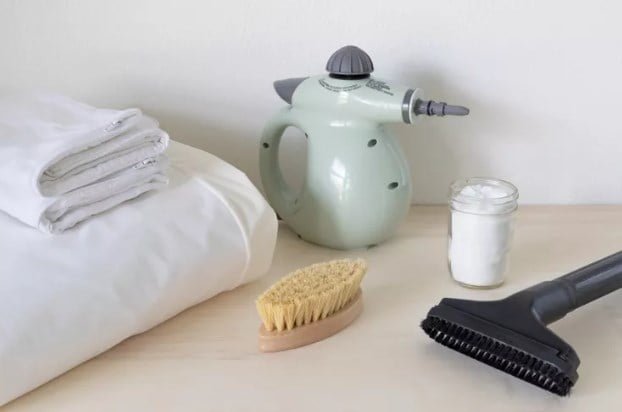Dust mites are everywhere in our homes, but they are found in the highest concentrations on surfaces that trap dust, like mattresses, curtains, and carpeting that can’t be washed regularly.
Dust mites are microscopic, arachnids that feed on the dead human skin cells we are constantly shedding. Unlike lice or bed bugs, they are not parasites that bite, sting, or burrow into our skin. Though it’s not unsafe to sleep with dust mites, they can disrupt sleep and cause discomfort. They may not cause any other health risks but some people can have allergic reactions by inhaling the proteins in dust that come from dust mite feces, urine, or decaying bodies.
Even though dust mites are microscopic, there are ways to tell if you have dust mites sleeping in your bed, including:
Finding dust mite debris such as tiny black or brown specks on the mattress
Feeling itchy skin while you’re in bed
Experiencing allergy symptoms while sleeping, such as watery eyes, runny nose, sneezing, a sore throat, coughing, or breathing problems

How Often to Clean Mattresses for Dust Mite Removal
If your mattress is not encased in a dust mite-proof case and you suffer from allergic reactions, you should vacuum your mattress at least monthly to reduce the number of dust mites. If the mattress has a dust-proof cover that is cleaned frequently, then a twice-yearly cleaning should be all that is needed.
How to Get Rid of Dust Mites in a Mattress
Remove All of the Bedding
Remove the bedcovers, sheets, pillowcases, mattress protector, and dust-proof cover from the mattress. If you have encased the bed pillows and box springs with a cover (and you should), remove them as well.
Wash the Bedding
To kill dust mites, put your bedding in the dryer for at least 15 minutes using your dryer’s high heat setting, which has temperatures of 135 degrees Fahrenheit. After killing the dust mites, wash and dry the bedding and dust covers as usual using your regular detergent in warm water.
Vacuum the Mattress
Use a vacuum with a HEPA (high-efficiency particulate air) filter, hose, and an upholstery brush attachment to vacuum every surface of the mattress. Don’t forget the sides and the box springs and vacuum or dust the bedframe as well.
Replace the Protective Covers and Bedding
When the bed is fully dry, replace the protective dust mite mattress cases and bedding.
How to Prevent Dust Mites in Mattresses
Cover your mattress, box springs, and pillows with insect and dust-proof covers. The covers can be made from non-porous materials like vinyl or plastic or a more breathable material like microfiber polyester or nylon, or even cotton that is tightly woven.
Wash bedding at least weekly. If you don’t want to wash your comforter or bedspread that frequently, you can place it in an automatic dryer on air-only to help remove dust and dust mites.
Remove excess items from the bed. Stuffed animals and decorative pillows harbor dust mites.
Reduce the humidity level in the bedroom to around 50 percent by using a dehumidifier, air conditioning, and running bathroom exhaust fans.
Lower the temperature to at least 68 degrees in the bedroom. This won’t prevent dust mites but it will slow their breeding cycle.
Allow the bedding to air and dry for a few minutes before you make the bed each morning.
Remove wall-to-wall carpeting and heavy drapes from the bedroom to reduce the level of dust in the room.
Use hypoallergenic pillows and mattresses. Latex foam mattresses are less hospitable to dust mites than those with cotton padding. Use foam pillows instead of down or feathers.
Upgrade your HVAC filters to HEPA filters and replace or clean them regularly.
Ban pets from the bedroom. Dust mites thrive in animal dander.








